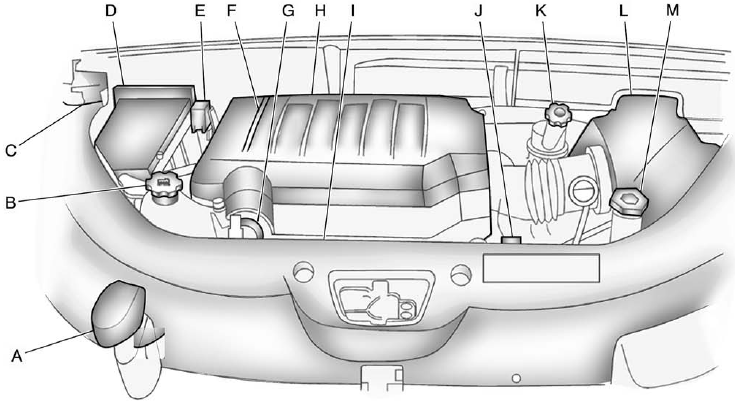Engine Compartment Overview

A. Radiator Pressure Cap. See Cooling System on page 10‑14.
B. Engine Coolant Recovery Cap. See Cooling System on page 10‑14.
C. Remote Negative (−) Terminal. See Jump Starting on page 10‑78.
D. Engine Compartment Fuse Block on page 10‑31.
E. Remote Positive (+) Terminal. See Jump Starting on page 10‑78.
F. Power Steering Reservoir and Cap (under engine cover). See Power Steering
Fluid on page 10‑21.
G. Engine Oil Fill Cap. See “When to Add Engine Oil” under Engine Oil on page
10‑8.
H. Engine Cover on page 10‑8.
I. Engine Oil Dipstick (out of view). See “Checking Engine Oil” under Engine Oil
on page 10‑8.
J. Automatic Transmission Fluid Dipstick. See “Checking the Fluid Level” under
Automatic Transmission Fluid on page 10‑12.
K. Brake Master Cylinder Reservoir. See “Brake Fluid” under Brakes on page
10‑22.
L. Engine Air Cleaner/Filter on page 10‑12.
M. Windshield Washer Fluid Reservoir. See “Adding Washer Fluid” under Washer
Fluid on page 10‑22.
See also:
Muting a Call
During a call, all sounds from inside the vehicle can be muted so that the person
on the other end of the call cannot hear them.
To mute a call, press , and then
say “Mute Call.”
To cancel m ...
Torque Lock
Torque lock is when the weight of the vehicle puts too much force on the parking
pawl in the transmission. This happens when parking on a hill and shifting the transmission
into P (Park) is not do ...
Sensors
The solar sensor, located on top of the instrument panel near the windshield,
monitors the solar heat. The climate control system uses the information to adjust
the temperature, fan speed, recircu ...





